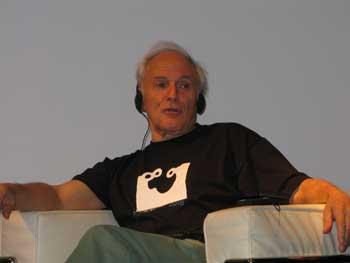At the beginning of the Atom by Atom congress, more than nanoscience, disclosure
2009/09/29 Lakar Iraizoz, Oihane - Elhuyar Zientzia
On the first day of the congress, however, nanoscience and nanotechnology did not have much weight. In the next two days experts will focus on these issues. Yesterday was the previous step to the descent to the nanoscale.
The welcome conference, given by Txema Pitark, Pedro Miguel Etxenike and Lehendakari Patxi López, highlighted in a few words the importance of nanoscience research, the importance of the scientific culture of society and the importance of allocating public funds to research, respectively.
From behind, Sir Harold Kroto, winner of the 1996 Nobel Prize in Chemistry, gave an inaugural lecture. The theme was science, society and sustainability. Once again, nanoscience and nanotechnology were few words of Kroto. But the disclosure, overwhelmingly, demonstrated his ability to communicate. And the Zinemaldia that just passed also made winks.

In fact, he went through his life at the beginning of the talk to explain why he became a researcher. Among other things, he mentioned an essay as an actor at school and showed a photograph of a play with his classmates. There he highlighted two characters, he and one of his companions, and said: "In the end I was not an actress and less bad! My assistant is now an actor and looks at his appearance," and showed the photo of Gandalfa, protagonist of the film series The Lord of the Rings. In fact, his partner was Ian McKellen, an actor awarded this year with the Festival's Donostia Award. While he was saying all this, he also removed the jacket and shirt he wore dressed, revealing the shirt he had underneath, just like Ian McKellene had on the day he received the prize: T-shirt promoted by Donostia as the European capital of culture.
With this he managed to conquer all audiences. From there he spoke of the importance of science in society. He gave continuous humorous touches to what he said. What he said were things of great weight. He noted, for example, that in order to obtain funding to conduct research, they call for ensuring that fruitful results will be obtained. Researchers, however, "don't know how far the research we do will go." He set as an example what he lived. He received the novel to discover fullerene, and today fullerene is manufactured industrially, "but when we discovered it we were studying the chemistry of stars." At that time they had not foreseen it, they could not foresee it, the uses they just found. "Science cannot be predicted, that is so. It's not my fault," he said.
He also commented on the major contributions that chemistry considers: anesthesia and penicillin. At the time they were invented, they brought great benefit to society. However, problems are changing and researchers are needed to solve these problems. He stressed that the future depends on scientists: "When you are a scientist you realize that the future depends on nobody."
Research is therefore essential and also the presence of people who will conduct research. It is necessary to create a spirit of research among young people to be researchers in the future. Speaking of researchers who have made great discoveries, such as Einstein, he stressed that they are shown photos of ancients. "Old scientists are not referents for young people. What is one of the characters that youth consider a reference?" asked showed a picture of Tom Cruis. "This is not scientific, this is scientific."
At the end of the talk, many people approached to take pictures. Like a Hollywood star. Hasn't the atmosphere created in Zinemaldia yet moved away? Who knows. Kroto, at least, represented perfectly what he said.

Gai honi buruzko eduki gehiago
Elhuyarrek garatutako teknologia






